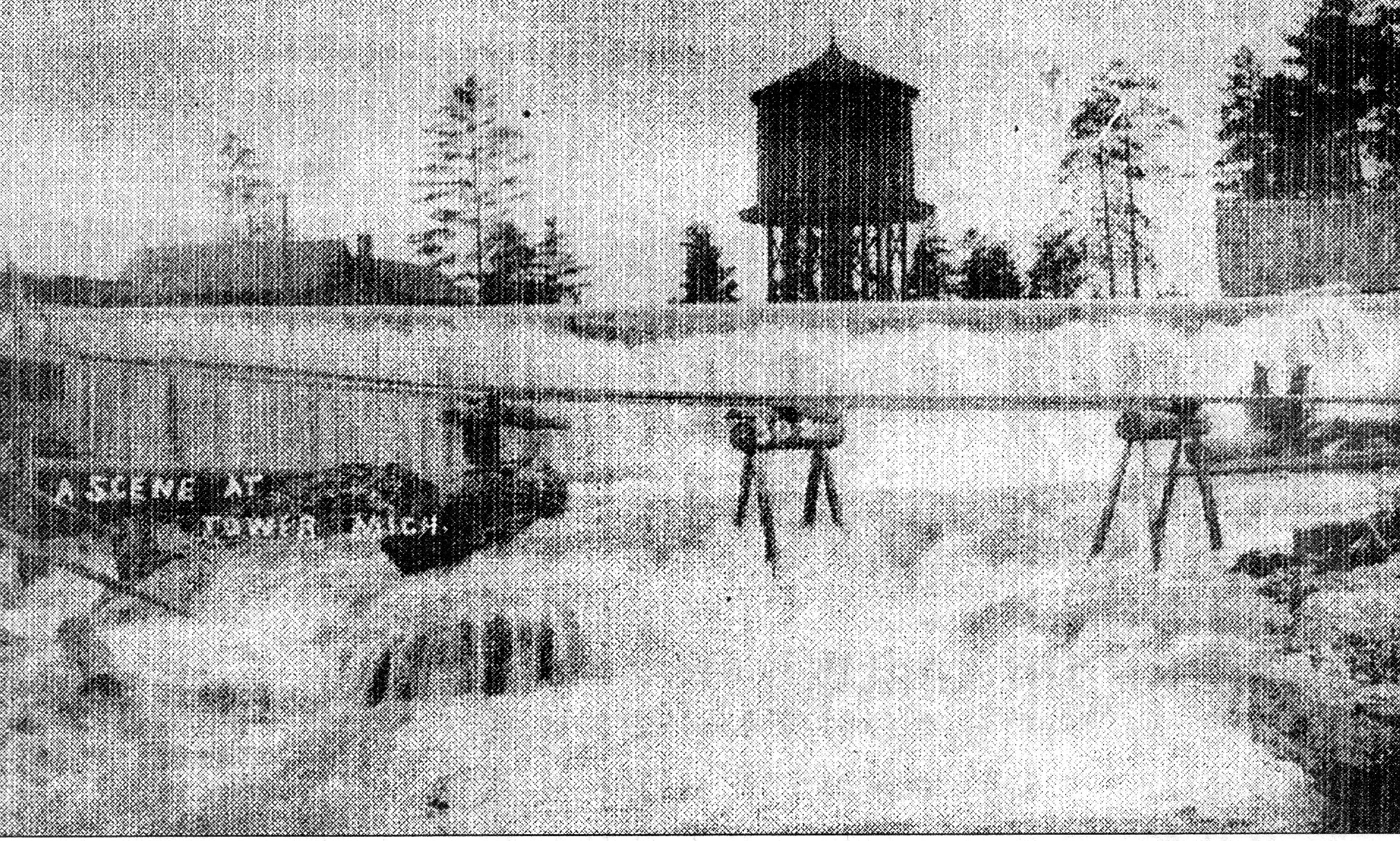
Submitted by Nute Chapman
From Onaway Outlook September 14, 2012

 |
Submitted by Nute Chapman From Onaway Outlook September 14, 2012 |
 |
Caption: An early 1900's scene at the Tower Dam
 We finally caught the train heading west to Waveland.
We finally caught the train heading west to Waveland.
We slowly build up steam as we pass the spurs going into the Huron Handle Company, later to be the American
Wood Rim Company. We pass the rails going north to the Onaway Limestone Company at Black Lake. As we move into
Cheboygan County, we cross the survey trail that will become the County Line Road.
A muddy two-track comes into the railroad from the south. This two-track later becomes the Black River Road.
It stops at the tracks at this time. It is here that Albert Teets has purchased 39 acres of prime red clay where
he is building a brickyard. He has hired an experienced brick maker by the name of John Landy. Mr. Landy has been
in the brick trade for 30 years in Hudson. The brick business in Hudson was considered one of the best in the state.
It wasn't long and Mr. Landy was producing 20,000 bricks a day, which were being shipped out on the Detroit & Mackinac
(D&M) Railroad.
One can still see the red clay in this area by looking to the west as you cross the tracks going north.
It is believed that the bricks for Henry's building and the Onaway Savings Bank, which still stands today, were
from Teet's Brickyard.
The Onaway School bricks were shipped in from outside.
As we chug along our next stop will be near Chandler's Dam in Tower. Tower already had two sawmills, a blacksmith
shop and other businesses started. Tower continued to grow and make history of its own; many articles and pictures are
out there to be enjoyed.
A long spur left Tower to the south and divided near the Meridian Line and both spurs paralleled the line into
sections 20 and 29, still in Cheboygan County. It is the east spur that ended up at the settlement of Paradise on
the Black River near Clark's Bridge. There were no roads in this area at this time and no bridge across the Black.
Paradise boasted a boarding house, several bunk houses, the Silver Dollar Saloon and Dance Hall, a cook shack, a
blacksmith shop and several horse barns.
Mark Dean is the proud owner of the only rail iron jig that I have ever seen. This jig was found by the late
Chet McQuaid at the settlement of Paradise. We hope this jig makes its way to the new museum.
Many spurs appeared later as the lumber business boomed. One of these spurs crossed the Ray Tucker farm and
went behind Leaton Stevens' property to the Gregg farm and on southwest across Buzzell Road to Van Horn's lumber
camp on the west side of Black River. Jim Post lives in this area today.
Now back to Tower. Another line left the main track and angled northwest crossing what is now Brady Road and went
through the Michael Demaestri farm, crossed the Meridian Line and ended up behind the Hogsback near LeGrand. Several
spurs were built off from this spur.
Back to Tower. We now pass the area where the two-track would go to the Shanty Rapids Bridge and cross the Black
River. Next we cross over what later becomes Penfold Pond, which is where the Welch Creek empties into the Black
River.
Our next water system we cross is the Milligan Creek close to where it empties into the Black River. It's only
a short ride and we cross a small trout stream that today has the name of Hughe's Creek. This name no doubt comes
from the Hughe's homestead in this area. I only know that I have creeled some nice brookies from the creek and put
some nice mink on a board that came from this water system.
The Waveland Crossing settlement ended up in Section 17, 18, 19 and 20 of Waverly Township. This was the end of
the line. Waveland had a water tower and several buildings and barns. By 1906 the D & M pushed the line on to
Cheboygan.
Today at Waveland Crossing four roads intersect with the railroad. Waveland Road comes from the south and goes
to the Red Bridge. Michigan State Road goes to Kentuckyville or LeGrand. Snake Trail or the Merchant Road---would go
to Cheboygan if it were not for the nice little sand piles (berms) that the Department of Natural Resources made
in the middle of the road. Section Line Road goes north next to the railroad.
There were other spurs added in later years to get to all of the timber and lumber camps. Maybe we will get some
of them untangled later.
-Onaway Outlook, September 14, 2012, p.10.
Retyped by J. Anderson.